 It is not always convenient for people with disabilities to read text on the phone screen. The shell developers MIUI (smartphones Xiaomi) took care of this and created a screen reader called TalkBack. Let's figure out how to use it.
It is not always convenient for people with disabilities to read text on the phone screen. The shell developers MIUI (smartphones Xiaomi) took care of this and created a screen reader called TalkBack. Let's figure out how to use it.
TalkBack is an application for reading text on the screen of your smartphone. It makes it easier for people with visual impairments to use a mobile device.
Turning on
To enable the program, go to Settings> Special. features> TalkBack.
Upon activation, an interactive tutorial will open, consisting of 5 lessons:
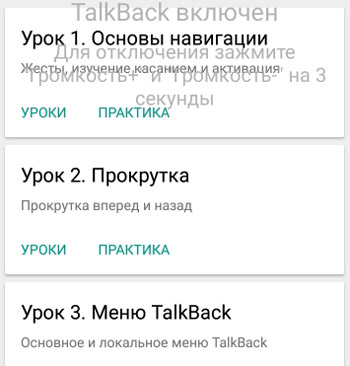
- Basics of navigation.
- Scrolling.
- TalkBack menu.
- Navigation through the text.
- Editing text.
Brief instructions:
- To move from one item to another, swipe left or right on the screen.
- To activate an object, click on it 2 times.
- To scroll the screen, swipe across it with two fingers.
Turn off TalkBack: Tap the switch. A green frame will appear. Press the switch 2 times. To confirm the action, click “OK”: first 1 time, then 2 times.
to the content
TalkBack Lesson 1 Navigation Basics
Part 1. Explore by touch. The device tells you which item you touched. Tap any of the items to go to the next part.

Part 2. Activation by double clicking. To activate the last sounded (selected) element, press 2 times on the screen anywhere.
Part 3. Navigation. All TalkBack lessons follow the same scheme. Basic information is at the top, and you can familiarize yourself with it at any time. In the upper left corner there is a button “Home screen of the manual”. The training area is located in the center. Below is a progress bar and lesson navigation buttons. Click “Next” to continue.
Part 4. Search using gestures. You can find the icons you want using special gestures. To move up and left, swipe left. Swipe right to move down and to the right.
Part 5. Practice. To hear which item you touched, swipe to the side. To activate the voiced item, double-tap anywhere on the screen. Swipe left or right to browse.
to the content
TalkBack Lesson 2 Scrolling
Part 1. Scrolling the screen with special gestures. You can scroll through the lists using specials. gestures. To scroll forward, swipe right and then left in one swipe (without lifting your finger from the screen). To scroll back, swipe left and then right (also keep your finger on the screen).

Part 2. Practice. Scroll forward by swiping right then left. Scroll back by swiping left, then right. Don't lift your finger off the screen !.
to the content
TalkBack Lesson 3 “Menus”
Part 1. Main menu. TalkBack has two types of menus. On the left (main), the commands are always the same. To turn it on, swipe down and then right. Then remove your finger from the screen.

Part 2. Local menu. Local menu items change depending on which item was last spoken. To enable this menu, swipe up and then right. Then remove your finger from the screen.

Part 3. Practice. Open the main menu – swipe down on the screen and then right without lifting your finger.
to the content
TalkBack: Lesson 4: Navigating Through Text
Part 1. Navigation settings. You can choose how the program will read the text: by paragraphs, lines, words or symbols. Reading by symbols helps you better understand the pronunciation of words. Turn on this mode by tapping on the text and then swiping up and down with one swipe of your finger.

Part 2. Navigation through the text. In the previous part, you enabled reading by character. To start it, select a sample text and swipe right.
Part 3. Practice. To change the reading mode, swipe up and down, and to read the next character in the text, swipe right.
to the content
TalkBack: Lesson 5 “Editing Text”
Part 1. Activation of the editing window. With TalkBack turned on, you can use the editing window to enter, select, and edit text. To activate this window, double click on it. A keyboard will appear at the bottom of the screen. Click Back to close it. Practice in the edit box below.

Part 2. Entering text in the editing window. To enter a character, activate the edit box and swipe across the keyboard on the screen until you hear the character you want. Then select it by lifting your finger.
Part 3. Editing with the cursor. You can move the cursor around the screen using the volume buttons on the side of the phone or through the local TalkBack menu. It has a Cursor Control function that lets you select, cut, copy and paste text.
Part 4. Practice. Activate the text editing window by clicking on it 2 times. Write text by sliding your finger across the keyboard and lifting it up each time you hear the character you want. Use the volume buttons on the cabinet to change the cursor position.
to the content
Application settings
Tap the Settings gear at the bottom of the screen in TalkBack.

to the content
Text-to-speech settings
We select the default synthesizer – I have it on Google.
- System language.
- Speech rate.
- Speech tone
- Listen to an example. Edit the settings for yourself.
- Default Speech Rate – Restore Speech Rate settings.
- Default tone – restore speech tone settings.
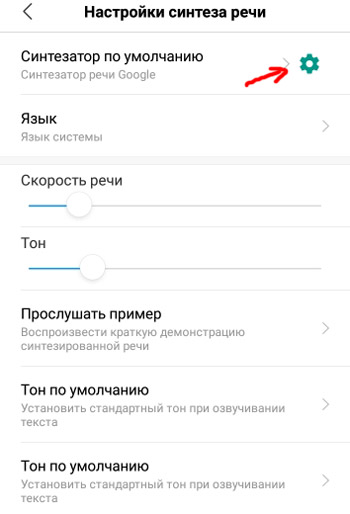
Click on the gear on the right.
- Install voice data – select your language. The voice package is downloaded from the Internet.
- Wi-Fi only – download voice packages only via Wi-Fi, so as not to consume mobile traffic.
- Speech volume – increase the speech volume if it is superimposed on another sound.
- Intonation: expressive, slightly expressive, even (neutral).
- Sound of numbers – affects the sound of the date and time.
- Language recognition: conservative or aggressive.
- Anonymous reports on speech synthesis – data about the use of this service is sent to the servers Xiaomi. Thanks to this, the company is working to improve it.
- Leave a review – you can write a review or your comments using mail.
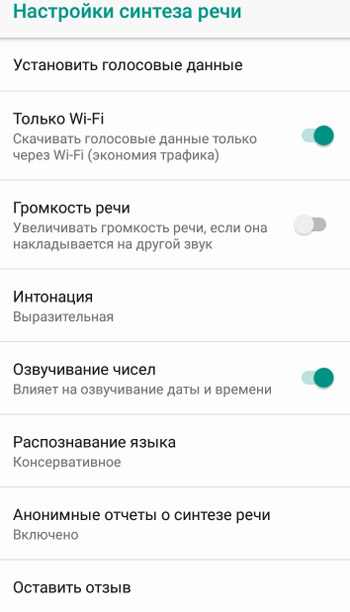
to the content
Detailing
You can choose a set of detail settings: high and low detail and special. capabilities (manual configuration). What settings are there?
- Speak keystrokes: always, on-screen keyboard only, never.
- Speak text – prompts are announced during navigation after a short delay.
- Speak information about lists and grids, i.e. in which position in the general list you are now.
- Speak number of items – speak only when scrolling the screen using gestures.
- Speak the element type.
- Sound phonetic symbols (they sound when you press the key for a long time and move the cursor over the symbols).
- Change Pitch When Speaking — Decrease the pitch when speaking keyboard input.
- When the screen is off – to voice or not.
- The order of description of elements: state, name, type; or in another order – choose yourself.
- Speak element identifiers. At the same time, the identifiers of buttons without labels are not read out.

to the content
Gestures
TalkBack provides the following default gestures for navigating the phone and managing objects and applications. Moreover, each gesture can be reconfigured for more than 20 actions.
- To the left is the previous object.
- To the right is the next object.
- Up and Down – select the first item on the screen.
- Down and Up – select the last item on the screen.
- Left and right – scroll back.
- Right and Left – Scroll forward.
- Up and Right – open the local context menu.
- Up and Left – Home button.
- Down and Right – open the general context menu.
- Down and left – Back button.
- Right and down – open the notification panel.
- Right and up – no action assigned, choose from more than 20 options.
- Left and Down – no action assigned, choose from more than 20 options.
- Left and Up – Browse button.
Fingerprint scanner gestures. There are only four of them. For each gesture, set the desired action. By default, gestures are not detected by the system.
- Up the scanner.
- Down the scanner.
- Left on the scanner.
- Right on the scanner.
Edge tapping (experimental, may malfunction). Actions for these gestures are not defined, choose yourself from the list. Additionally, you can adjust the sensitivity of the sensor for tapping.
- Single tapping.
- Double tapping.
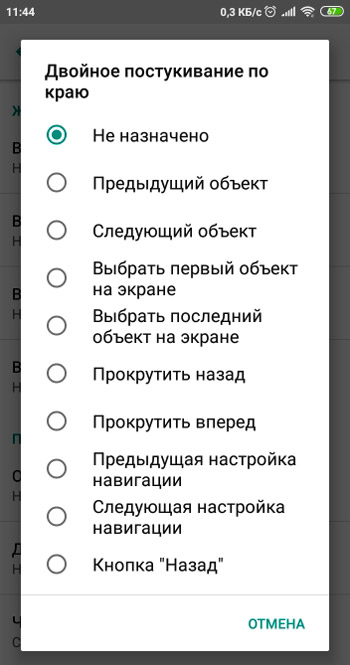
to the content
Other settings
- Distance sensor – detects how far you are from the phone and adjusts the volume of your speech.
- Shake to start reading – shake your phone and TalkBack reads your text or menu.
- Speaking of passwords. Passwords will be announced only when headphones are connected to the phone.
- Vibration feedback – there will be vibration for every action.
- Sound response and sound volume. response – there will be a sound confirmation for each action. You can adjust the volume of this confirmation.
- Mute applications when TalkBack is running to avoid interrupting audio.
- Auto-scrolling lists.
- One Click Activation – Activate selected items with one click. I do not recommend using it to avoid mistakes, accidental operation. Better to leave a double tap to activate the selected object.
- Context menu in the form of a list.
- Select Settings – Global TalkBack settings. Show or hide the following settings in the menu:
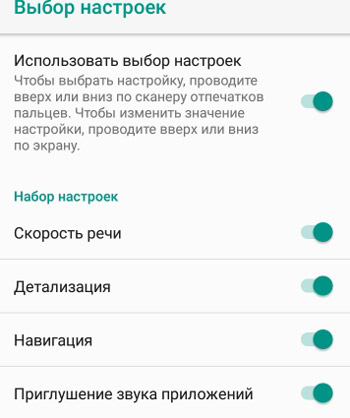
- Keyboard shortcuts – a set of keyboard shortcuts, navigation, general actions on the phone (back, home screen, notifications, recent apps), additional actions, actions for web navigation. There are really a lot of keyboard shortcuts, and people with visual impairments will have to learn them.
- Personal shortcuts – a list of your personal shortcuts. From this menu, you can import (upload) or export (send) shortcuts to another device.
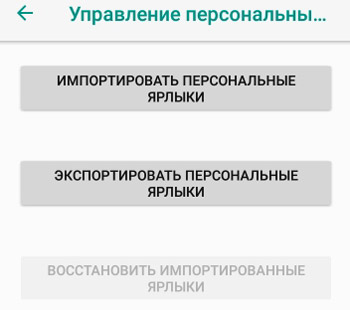
- Explore by touch – the phone responds to your gestures and names items when you touch the screen.
- Move focus between screens – whether or not to move focus to the initial or previous position when switching to another screen. For example, the desktop is one screen, here the focus is in the middle; when you open the application, this is the second screen, here the focus can be by default or as you left it last time using this application.
- TalkBack Guide – If you've forgotten how to use the app, take the gesture tutorial again.
to the content
Sound when pressed
Another feature for screen readers. You can select objects on the screen and hear their names or descriptions. To activate the function, go to Settings> Advanced settings> Special. features> Sound on click.
For example, click on any icon and try:
- select some element: text or image;
- slide your finger across the screen to select multiple items;
- press the play button to sound everything on the screen.
To configure the function, click on the gear at the bottom of the screen. The following options are available here:
- Read in the background – when you change the main screen (switch from one application to another), the text will not stop playing. This function does not always work correctly and can mislead which application you are currently using on the phone. I do not recommend using it.
- Speak Text From Images – Speaks out text from a camera or photo.
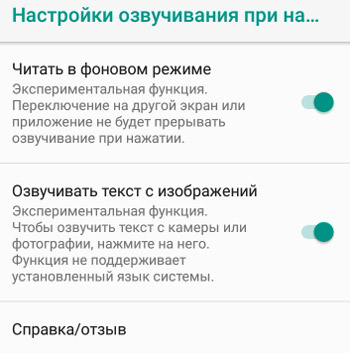
Let's summarize. We examined how to work with the TalkBack voice-over application, analyzed all the available gestures for navigating and controlling a smartphone, you can change each gesture to suit you – choose the desired action. We have adjusted the level of audio detail, whether it is worth voicing all the elements on the screen or only some. We studied several experimental functions that first appeared in spec. opportunities for people with visual impairments.
Of course, setting up the application, memorizing gestures and shortcuts will take time. But with such knowledge, even a blind person will be able to control his phone, call loved ones or write messages, visit sites on the Internet and listen to all the information.
